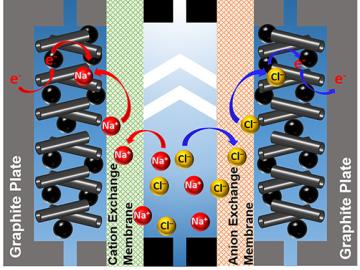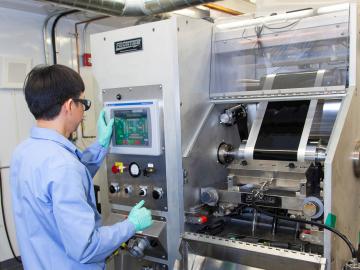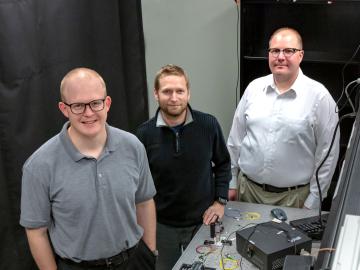
Filter News
Area of Research
- (-) Energy Science (106)
- (-) Nuclear Science and Technology (13)
- (-) Supercomputing (68)
- Advanced Manufacturing (1)
- Biology and Environment (58)
- Biology and Soft Matter (1)
- Computational Engineering (1)
- Computer Science (5)
- Electricity and Smart Grid (1)
- Energy Frontier Research Centers (1)
- Energy Sciences (1)
- Functional Materials for Energy (2)
- Fusion and Fission (12)
- Fusion Energy (7)
- Isotopes (2)
- Materials (111)
- Materials for Computing (12)
- Mathematics (1)
- National Security (9)
- Neutron Science (32)
- Nuclear Systems Modeling, Simulation and Validation (1)
- Quantum information Science (9)
News Topics
- (-) Advanced Reactors (16)
- (-) Clean Water (8)
- (-) Energy Storage (74)
- (-) Nanotechnology (15)
- (-) Physics (10)
- (-) Quantum Computing (20)
- (-) Quantum Science (26)
- 3-D Printing/Advanced Manufacturing (83)
- Artificial Intelligence (42)
- Big Data (27)
- Bioenergy (29)
- Biology (19)
- Biomedical (24)
- Biotechnology (6)
- Buildings (39)
- Chemical Sciences (16)
- Composites (17)
- Computer Science (109)
- Coronavirus (25)
- Critical Materials (12)
- Cybersecurity (15)
- Environment (69)
- Exascale Computing (27)
- Fossil Energy (2)
- Frontier (32)
- Fusion (10)
- Grid (41)
- High-Performance Computing (44)
- Hydropower (3)
- Isotopes (7)
- Machine Learning (20)
- Materials (45)
- Materials Science (43)
- Mathematics (4)
- Mercury (3)
- Microelectronics (1)
- Microscopy (14)
- Molten Salt (5)
- National Security (11)
- Neutron Science (23)
- Nuclear Energy (44)
- Partnerships (12)
- Polymers (13)
- Security (10)
- Simulation (18)
- Software (1)
- Space Exploration (10)
- Statistics (1)
- Summit (44)
- Transportation (70)
Media Contacts

In a step toward advancing small modular nuclear reactor designs, scientists at Oak Ridge National Laboratory have run reactor simulations on ORNL supercomputer Summit with greater-than-expected computational efficiency.

Ionic conduction involves the movement of ions from one location to another inside a material. The ions travel through point defects, which are irregularities in the otherwise consistent arrangement of atoms known as the crystal lattice. This sometimes sluggish process can limit the performance and efficiency of fuel cells, batteries, and other energy storage technologies.

A team of scientists led by Oak Ridge National Laboratory used carbon nanotubes to improve a desalination process that attracts and removes ionic compounds such as salt from water using charged electrodes.

OAK RIDGE, Tenn., March 11, 2019—An international collaboration including scientists at the Department of Energy’s Oak Ridge National Laboratory solved a 50-year-old puzzle that explains why beta decays of atomic nuclei

The use of lithium-ion batteries has surged in recent years, starting with electronics and expanding into many applications, including the growing electric and hybrid vehicle industry. But the technologies to optimize recycling of these batteries have not kept pace.
OAK RIDGE, Tenn., Feb. 12, 2019—A team of researchers from the Department of Energy’s Oak Ridge and Los Alamos National Laboratories has partnered with EPB, a Chattanooga utility and telecommunications company, to demonstrate the effectiveness of metro-scale quantum key distribution (QKD).

Scientists at Oak Ridge National Laboratory and Hypres, a digital superconductor company, have tested a novel cryogenic, or low-temperature, memory cell circuit design that may boost memory storage while using less energy in future exascale and quantum computing applications.

Oak Ridge National Laboratory scientists studying fuel cells as a potential alternative to internal combustion engines used sophisticated electron microscopy to investigate the benefits of replacing high-cost platinum with a lower cost, carbon-nitrogen-manganese-based catalyst.

By analyzing a pattern formed by the intersection of two beams of light, researchers can capture elusive details regarding the behavior of mysterious phenomena such as gravitational waves. Creating and precisely measuring these interference patterns would not be possible without instruments called interferometers.

The Department of Energy’s Oak Ridge National Laboratory is collaborating with industry on six new projects focused on advancing commercial nuclear energy technologies that offer potential improvements to current nuclear reactors and move new reactor designs closer to deployment.


